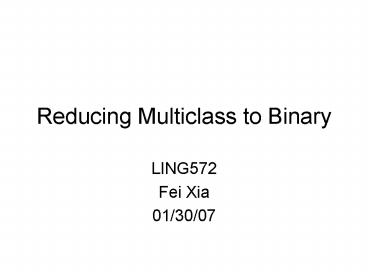Reducing Multiclass to Binary - PowerPoint PPT Presentation
1 / 19
Title:
Reducing Multiclass to Binary
Description:
For some ML algorithms, a direct extension to the multiclass case may be ... Row separations: Each codeword should be well-separated in Hamming distance from ... – PowerPoint PPT presentation
Number of Views:62
Avg rating:3.0/5.0
Title: Reducing Multiclass to Binary
1
Reducing Multiclass to Binary
- LING572
- Fei Xia
- 01/30/07
2
Highlights
- What?
- Converting a k-class problem to a binary problem.
- Why?
- For some ML algorithms, a direct extension to the
multiclass case may be problematic. - Ex Boosting, support-vector machines (SVM)
- How?
- Many methods
3
Methods
- One-vs-all
- All-pairs
- Error-correcting Output Codes (ECOC)
4
One-vs-all
- Idea
- Each class is compared to all others.
- K classifiers
- Training time
- For each class ci, train a classifier fi(x)
- replace (x,y) with
- (x, 1) if y ci
- (x, 0) if y ! ci
5
One-vs-all (cont)
- Testing time given a new example x
- Run each of the k classifiers on x
- Choose the class ci with the highest confidence
score fi(x) - c arg maxi fi(x)
6
All-pairs
- Idea
- all pairs of classes are compared to each other
- Ck2 classifiers.
- Training
- For each pair (ci, cj) of classes, train a
classifier fij - replace (x,y) with
- (x, 1) if y ci
- (x, 0) if y cj
- o.w. ignore it
7
All-pairs (cont)
- Testing time given a new example x
- Run each of the Ck2 classifiers on x
- Max-win strategy Choose the class ci that wins
the most pairwise comparisons - Other coupling models have been proposed e.g.,
(Hastie and Tibshirani, 1998)
8
Error-correcting output codes (ECOC)
- Proposed by (Dietterich and Bakiri, 1995)
- Idea
- Each class is assigned a unique binary string of
length n. - Train n classifiers, one for each bit.
- Testing time run n classifiers on x to get a
n-bit string s, and choose the class which is
closest to s.
9
An example
10
Meaning of each column
11
Another example 15-bit code for a 10-class
problem
12
Hamming distance
- Definition the Hamming distance between two
strings of equal length is the number of
positions for which the corresponding symbols are
different. - Ex
- 10111 and 10010
- 2143 and 2233
- Toned and roses
13
How to choose a good error-correcting code?
- Choose the one with large minimum Hamming
distance between any pair of code words. - If the min Hamming distance is d, then the code
can correct at least (d-1)/2 single bit errors.
14
Two properties of a good ECOC
- Row separations Each codeword should be
well-separated in Hamming distance from each of
the other codewords - Column separation Each bit-position function fi
should be uncorrelated with each of the other fj.
15
All possible columns for a three-class problem
If there are k classes, there will be at most
2k-1 -1 usable columns after removing complements
and the all-zeros or all-ones column.
16
Finding a good code for different values of k
- Exhaustive codes
- Column selection from exhaustive codes
- Randomized hill climbing
- BCH codes
17
Results
18
Summary
- Different methods
- Direct multiclass
- One-vs-all (a.k.a. one-per-class) k-classifiers
- All-pairs Ck2 classifiers
- ECOC n classifiers (n is the num of columns)
- Some studies report that All-pairs and ECOC work
better than one-vs-all.
19
Questions?
- Hw4 Compare different methods
- Direct multiclass
- One-vs-all
- All-pairs
- ECOC (optional)
- Group project 1 or 2 persons per group































